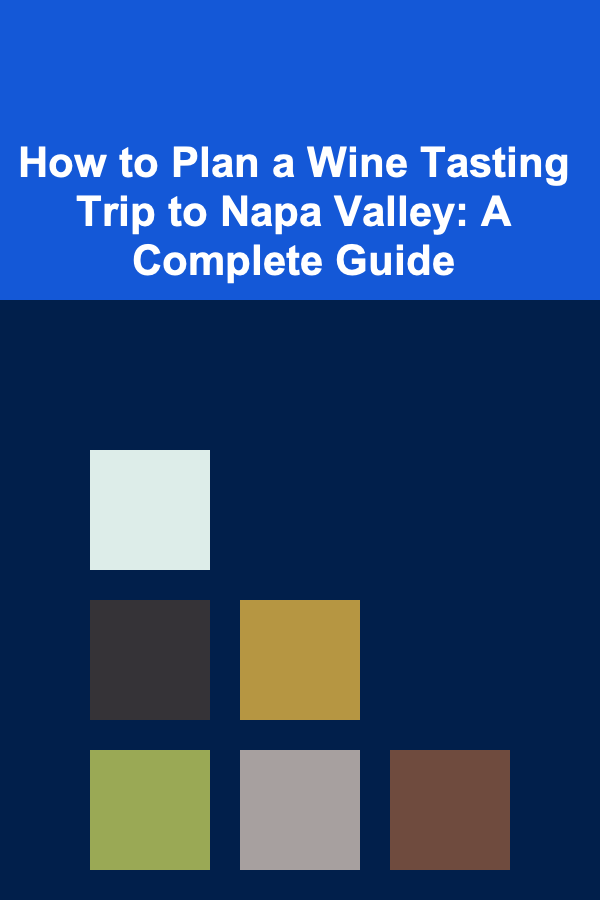
How to Plan a Wine Tasting Trip to Napa Valley: A Complete Guide
ebook include PDF & Audio bundle (Micro Guide)
$12.99$9.99
Limited Time Offer! Order within the next:

Wine tasting trips offer a chance to experience the beauty of a region, its culture, and the artistry behind wine production. One of the most renowned wine regions in the world is Napa Valley, located in California, USA. Napa Valley is famous for its scenic vineyards, exquisite wines, and world-class wineries. Whether you're a seasoned wine enthusiast or a beginner, planning a wine-tasting trip to Napa Valley can be an unforgettable experience. This guide will walk you through the steps of organizing the perfect wine-tasting getaway, from choosing the best time to visit to understanding wine basics, exploring top wineries, and making the most of your trip.
Choosing the Best Time to Visit Napa Valley
The first step in planning a wine-tasting trip to Napa Valley is determining when to go. Napa Valley is a year-round destination, but the timing of your visit can greatly influence your experience. Here are some factors to consider when choosing the best time to visit:
1.1 Harvest Season (August to October)
If you want to witness the excitement of the harvest and experience Napa Valley at its busiest, plan your trip during the harvest season, which typically occurs from late August through October. This is when grapes are picked, and wineries often host special events, tours, and tastings. Keep in mind that harvest season can be crowded, and accommodations may be more expensive. However, it's also when the valley looks most picturesque, with vibrant autumn colors and a bustling atmosphere.
1.2 Off-Peak Season (November to March)
If you prefer a more tranquil experience with fewer crowds, consider visiting Napa Valley during the off-peak season, from November to March. During this time, the valley is less crowded, and you may find more affordable accommodations. While some wineries may close temporarily, many remain open and offer intimate, relaxed tastings. The weather can be cool and rainy, but the peaceful atmosphere makes it a great time for those who prefer a quieter wine-tasting experience.
1.3 Spring (April to June)
Spring is another ideal time to visit Napa Valley, with pleasant weather and fewer tourists compared to the summer months. The vineyards come alive with blooming flowers, and the valley is lush and green. This is also a great time to take advantage of lower hotel rates and enjoy outdoor activities, such as hiking and bike tours, in addition to wine tastings.
1.4 Summer (July to Early August)
Summer in Napa Valley can be hot, with temperatures often rising above 90°F (32°C), especially in July and early August. However, the wineries are in full swing, and many offer special summer events, such as outdoor wine festivals and concerts. If you don't mind the heat and want to experience Napa Valley at its liveliest, summer may be the right time for you.
Deciding How Long to Stay
A wine-tasting trip to Napa Valley can range from a weekend getaway to a full week of exploration. The length of your trip depends on several factors, including how many wineries you want to visit and what other activities you wish to include in your itinerary.
2.1 Weekend Trip (2-3 Days)
If you have limited time, a weekend trip to Napa Valley can be plenty of time to explore some of the region's best wineries and enjoy a few local attractions. A typical weekend itinerary could include wine tastings at 3-4 wineries, a visit to the famous Oxbow Public Market, and a relaxing dinner at a Michelin-starred restaurant.
2.2 Extended Stay (4-7 Days)
For a more immersive experience, plan a trip of 4-7 days. This will give you ample time to visit a variety of wineries, attend specialized tours and tastings, and explore other attractions such as art galleries, spas, and hiking trails. You'll also have time to explore the nearby wine regions, such as Sonoma County and Mendocino, if you want to broaden your wine-tasting adventure.
Selecting the Right Wineries to Visit
Napa Valley is home to over 400 wineries, each offering a unique experience. Whether you are interested in large, iconic estates or small, family-owned boutique wineries, there is something for everyone. Here are some tips for selecting the right wineries to visit:
3.1 Research Wineries Based on Wine Type
Napa Valley is known for its Cabernet Sauvignon, but it is also famous for other wine varieties, such as Merlot, Chardonnay, Zinfandel, and Pinot Noir. If you have a favorite type of wine, research wineries that specialize in that varietal. Some wineries focus exclusively on Bordeaux-style reds, while others offer a diverse range of wines.
3.2 Consider the Winery Experience
Each winery offers a different type of tasting experience. Some wineries have lavish tasting rooms with luxurious amenities, while others are more rustic and intimate. Many wineries offer guided tours, food pairings, or educational tastings, where you can learn about the winemaking process. Some even offer VIP experiences, such as private tours with the winemaker or behind-the-scenes access to production facilities. Decide whether you prefer a laid-back, casual experience or a more structured, educational visit.
3.3 Reservations and Tasting Fees
Most wineries in Napa Valley require reservations, especially during peak seasons, so it's essential to plan ahead and secure your spots in advance. Tasting fees typically range from $20 to $100+ per person, depending on the winery's exclusivity and the type of experience offered. Keep in mind that some high-end wineries may offer complimentary tastings if you purchase a bottle or join their wine club.
3.4 Top Napa Valley Wineries to Visit
Here are some of the most famous and highly recommended wineries in Napa Valley:
- Robert Mondavi Winery: A flagship winery that offers a comprehensive experience, from tasting world-class wines to learning about the winemaking process.
- Opus One: Known for its luxurious wines and stunning estate, Opus One offers an exclusive and high-end tasting experience.
- Domaine Carneros: Famous for its sparkling wines, Domaine Carneros is located in a beautiful chateau-style building with sweeping views of the valley.
- Castello di Amorosa: This medieval-style castle offers a unique, fun experience with a combination of wine tasting and exploration of the impressive architecture.
- V. Sattui Winery: A family-friendly winery that offers a wide selection of wines and a picnic area perfect for a leisurely lunch.
Understanding Wine Tasting Etiquette
Wine tasting etiquette can enhance your experience and help you make the most of your visit. Here are some tips to keep in mind:
4.1 Take Your Time
Wine tasting is not a race. Take your time to savor each wine, and don't rush through the tasting. Pay attention to the appearance, aroma, and flavor of the wine. It's okay to take notes and ask the staff questions about the wine, the winery, and the winemaking process.
4.2 Use the Spittoon
Most wine tastings will offer a spittoon or bucket where you can spit out wine after tasting. This is especially helpful if you plan on visiting several wineries in one day. Spitting allows you to enjoy the flavors without getting too intoxicated.
4.3 Limit the Number of Wineries Per Day
While it may be tempting to visit as many wineries as possible, it's best to limit the number to 3-4 per day. This will ensure that you have enough time to fully enjoy each tasting, ask questions, and explore the winery grounds. Drinking too much at once can also impair your ability to appreciate the wines fully.
Additional Activities and Attractions in Napa Valley
While wine tasting is the main attraction in Napa Valley, the region offers plenty of other activities that can complement your trip:
5.1 Hot Air Balloon Ride
One of the most breathtaking ways to experience Napa Valley's rolling hills and vineyards is by taking a hot air balloon ride. Several companies in the region offer early morning flights, providing panoramic views of the valley as the sun rises.
5.2 Spa Day
Napa Valley is known for its luxurious spas, many of which feature wine-based treatments. Treat yourself to a relaxing massage, facial, or mud bath after a day of wine tasting to rejuvenate your senses.
5.3 Culinary Delights
Napa Valley is home to some of the best restaurants in California, ranging from Michelin-starred fine dining to charming farm-to-table eateries. Many wineries also have on-site restaurants where you can enjoy gourmet meals paired with wines from the estate.
Travel Tips for Your Napa Valley Wine Tasting Trip
Here are a few practical tips to ensure your wine-tasting trip goes smoothly:
- Rent a Car: Napa Valley is spread out, and having a car will allow you to visit multiple wineries and explore the region at your own pace.
- Stay Hydrated: Wine tasting can dehydrate you, so be sure to drink plenty of water throughout the day.
- Dress Comfortably: Napa Valley has a Mediterranean climate, so wear layers and comfortable shoes, especially if you plan on walking around the vineyards.
- Plan for Transportation: If you plan to indulge in wine tastings, consider hiring a driver, taking a guided tour, or using a wine shuttle service to avoid drinking and driving.
Conclusion
A wine-tasting trip to Napa Valley offers an opportunity to explore some of the finest wines in the world, learn about the winemaking process, and immerse yourself in the beauty of California's wine country. By choosing the right time to visit, selecting the best wineries, and embracing the wine-tasting etiquette, you can create an unforgettable experience that combines education, relaxation, and indulgence.
Whether you're a first-time visitor or a seasoned wine lover, Napa Valley has something to offer everyone. From the moment you set foot in the valley, you'll be captivated by the charm, the beauty, and, of course, the wine. So, raise a glass, and enjoy your wine-tasting adventure in one of the world's most celebrated wine regions!
Reading More From Our Other Websites
- [Personal Care Tips 101] How to Use Breathwork for Relaxation and Stress Reduction
- [Home Space Saving 101] How to Create Efficient Entryway Organization for Small Apartments: Welcoming Guests Without Wasting Space
- [Personal Care Tips 101] How to Use Hair Oil to Prevent Split Ends
- [Home Storage Solution 101] How to Make the Most of Nooks and Crannies for Extra Storage
- [Tie-Dyeing Tip 101] DIY Tie‑Dye Sessions: Setting Up a Home Studio for Your Hobby Adventures
- [Rock Climbing Tip 101] Overcoming Fear on the Wall: Mental Techniques Every Climber Needs
- [Personal Financial Planning 101] How to Diversify Your Investment Portfolio for Stability
- [Personal Finance Management 101] How to Build Wealth Through Passive Income Streams
- [Personal Care Tips 101] How to Create a Nail Care Routine for Healthy, Beautiful Nails
- [Personal Investment 101] How to Optimize Your Retirement Savings Using Advanced Strategies

How to Cook for a Healthy Gut
Read More
How to Handle Tenant Maintenance Requests Promptly
Read More
How to Protect Your Finances During Economic Uncertainty
Read More
How to Master Time Management for a Fulfilling Life
Read More
Applying Analytical Philosophy to Clear Thinking
Read More
How to Use a Family To-Do List to Foster Responsibility and Teamwork
Read MoreOther Products

How to Cook for a Healthy Gut
Read More
How to Handle Tenant Maintenance Requests Promptly
Read More
How to Protect Your Finances During Economic Uncertainty
Read More
How to Master Time Management for a Fulfilling Life
Read More
Applying Analytical Philosophy to Clear Thinking
Read More